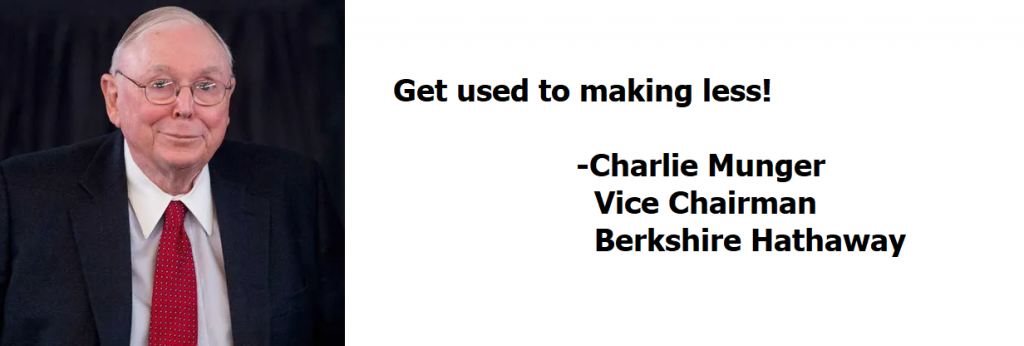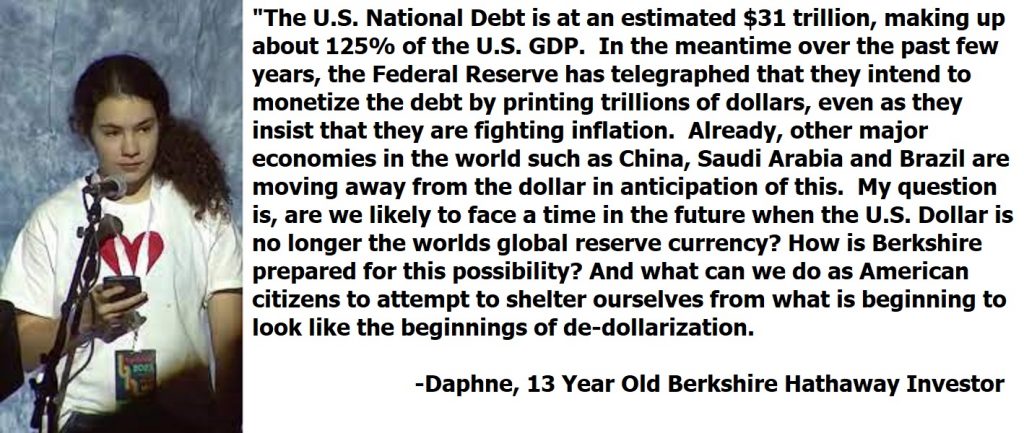
Occasionally stock market titans grant media interviews or make public pronouncements. When this occurs, I have always found it valuable to pay attention and to be prudent in carefully evaluating what they say. Over the last two weeks, two giants of the financial markets, Warren Buffett and Stanley Druckenmiller have issued public commentary that is notable and worthy of every trader’s attention.
It is crucial to approach trading and investing with utmost caution and care, especially considering recent remarks made by the highly regarded Warren Buffett. Known for his economic insights and Berkshire Hathaway Inc.’s deep ties to the American economy, Buffett recently expressed a somber prediction regarding his own businesses: the good times may be coming to an end.
At Berkshire’s annual general meeting in Omaha, Nebraska, Buffett, a billionaire investor, foresees a decline in earnings for the majority of the conglomerate’s operations this year. This anticipated downturn is expected to slow economic activity, signaling a cautionary outlook. Despite Berkshire’s solid performance in the first quarter, with operating earnings rising by almost 13% to $8.07 billion, Buffett expressed concerns about the months ahead.
Addressing crowds of thousands, the 92-year-old investor stated, “The majority of our businesses will report lower earnings this year than last year.” He went on to mention that the incredible period for the US economy over the past six months or so is drawing to a close.
Given the broad range of Berkshire’s businesses, spanning industries such as railroads, electric utilities, and retail, the Berkshire-Hathaway conglomerate is often viewed as a barometer of economic health. Buffett himself attributes Berkshire’s success to the remarkable growth of the US economy over the years. However, his prediction of a slowdown within his own firms coincides with concerns over regional banks facing upheaval that may curtail lending due to rising inflation and interest rates.
Adding to the cautious sentiment, Buffett’s long-time business partner, Charlie Munger, aged 99, joined him on stage and highlighted the more challenging economic environment ahead. Munger suggested that value investors, who typically seek stocks with favorable price-to-value ratios, may face greater difficulties in this climate. In essence, he cautioned investors to prepare for a scenario where making less becomes the norm. Munger bluntly stated, “get used to making less.”

These cautionary remarks from two highly respected figures in the financial markets serve as a reminder of the importance of careful and prudent decision-making in the face of potential economic headwinds.
Ever since the legendary Warren Buffett assumed control of Berkshire in 1965, the S&P 500 has recorded an astonishing cumulative gain of approximately 24,708%. Brace yourselves for this jaw-dropping fact: Over that same mind-blowing period, Berkshire’s stock has soared an astronomical cumulative 3,787,464%! Yes, you heard it right! That’s a mind-boggling 153 times more than the performance of the market benchmark!
Berkshire Hathaway’s performance under Buffett’s leadership has been nothing short of extraordinary. The company has defied all expectations, delivering astronomical returns.
These mind-boggling figures serve as a testament to Buffett’s unparalleled investing prowess and Berkshire’s remarkable track record. It’s no wonder that investors around the globe marvel at the sheer magnitude of Berkshire’s growth and consider Warren Buffett a true maestro of the financial world.
One of the highlights of the Berkshire Hathaway meeting was when a 13-year-old girl named Daphne, took the open mic, and asked the following question to Buffett and Munger:

We applaud this brilliant 13-year-old for her very thoughtful question. It is this question that we address on a regular basis on this blog. We consider it the most vital question of our time.
Mr. Buffett’s response was, “we are the worlds reserve currency, and I see no option for any other currency to become the world’s reserve currency.”
While I agree with Mr. Buffet in principle, I think he sidestepped the question. We may continue to be the world’s reserve currency for many more years. But to think that major economies moving away from trading in dollars does not pose a severe economic threat to the status quo is wishful thinking at best. It is hard to be defensive towards a danger that the Buffett generation could not have imagined would ever exist.
Meanwhile, another investing legend, Stanley Druckenmiller shared similar sentiments at the online SOHN investment Conference earlier this month. Druckenmiller gained recognition as the lead portfolio manager for George Soros’ Quantum Fund from 1988 to 2000. During his tenure, he delivered exceptional returns, with an average annualized return of around 30%. His most notable achievement came in 1992 when he famously bet against the British pound, a trade known as “Black Wednesday,” which earned him substantial profits and solidified his reputation as a skilled trader.
Druckenmiller combines top-down analysis with detailed research to make informed investment decisions.
His investment philosophy revolves around flexibility and adaptability. Druckenmiller believes in being open to changing market conditions and adjusting strategies accordingly. He is known for his ability to quickly identify opportunities and make decisive moves, emphasizing risk management and capital preservation.
Druckenmiller’s success stems from his deep understanding of macroeconomics, his ability to anticipate market shifts, and his disciplined execution. His investment style incorporates both long and short positions across various asset classes, including currencies, commodities, and equities.
Known for his laser-focused concerns over fiscal deficits, Druckenmiller drew our attention to a pressing issue: the unchecked future government spending and America’s skyrocketing debt. It’s a real doozy, folks! We’re talking a mind-boggling $32 trillion in US debt that’s increasing by a staggering $1 trillion every six months, not to mention the eye-popping $200 trillion in off-balance sheet debt that’s here to stay… at least until we face the dreaded prospects of default or hyperinflation.
During his speech at the USC Marshall School of Business, Druckenmiller painted a vivid picture of the last decade’s fiscal recklessness as a bone-chilling horror movie unfolding before our very eyes.
Druckenmiller warned that the US economy is teetering on the edge of a recession. Brace yourselves for a potential “hard landing.” He cautioned us about the impending consequences, including regional bank failures and corporate bankruptcies, which would only make matters worse. It’s a tough pill to swallow, he warned.
These sentiments from Druckenmiller aren’t new. A decade ago, during his whirlwind tour of universities, he astutely predicted the ballooning federal deficits that would haunt future generations. And guess what? He was right on the money! He foresaw an economic storm that could surpass the pain of the 2008 financial crisis. But now he claims the situation is even direr than he had imagined a decade ago.
Druckenmiller hammered home the runaway entitlements. We’re talking Social Security, Medicare, and Medicaid. These entitlement programs are the real deal, posing the most significant challenge to the US. Unless we make immediate cuts, we’re inevitably heading for drastic reductions in the future.
Now, let’s talk about the Federal Reserve. Druckenmiller questioned their actions and raised concerns about the repercussions of their easy-money policies in recent decades. He expressed doubt about their ability to solve fiscal problems while still holding a substantial amount of government debt. It’s like they’re waving a magic wand, perpetuating the false illusion of their efficacy.
While Druckenmiller acknowledged the Fed’s recent move in the right direction by raising interest rates 5 percentage points over the past year, attempting to rectify past mistakes, he raised eyebrows over their determination to stay the course. In just four days, the Fed undid most of the progress they had made in reducing their balance sheet in response to signs of trouble when Silicon Valley Bank imploded. It’s an asymmetric response that hampers serious structural action in Washington.
Druckenmiller leans bearishly on the markets but tries to remain open minded. While he doesn’t see a 2008 meltdown occurring, he also doesn’t rule it out. He claims that the current macroeconomic environment is the most difficult of his star-studded career. Most notably this is so because of his concerns with interest rates and Fed policy, ongoing structural deficits, the Ukraine War, the China-Taiwan conflict, and potential U.S. entanglement along with structural issues related to the U.S. dollar.
Here are the notable quotes from Druckenmiller himself at the SOHN Conference:
“This constant repeating that this looks nothing like ’08 or ’07. First of all, those who are saying it, I don’t remember them predicting in 2007 what was ahead of them, and I don’t remember people saying the banking system was that weak going in,” he said.
“When you have free money, people do stupid things. When you have free money for 11 years, people do really stupid things. So, there’s stuff under the hood, it’s starting to emerge. Obviously, the regional banks recently, we had Bed, Bath and Beyond [file for bankruptcy]. But I would assume there’s a lot more bodies coming.”
‘The arithmetic doesn’t work.’
“If nothing changes, pensions tomorrow will be a fraction of what they are today, and the government won’t be able to pay for more than half of your healthcare bills.”
“Think about it: in 20 or 30 years, there will be fewer young workers, many more seniors that need support … and the starting point is the highest national debt in our history.”

“It’s a scary cocktail that we’re being presented with.”
“If I liked the stock market, I would be exposed to it, and I’m not exposed to it.”
Fascinating, isn’t it? Two of the brightest and most successful investing wizards see massive headwinds for the financial markets moving forward.
As traders, we constantly face the challenge of making effective decisions. It’s not just about logical choices but also ensuring they are profitable and correct. Hope is not a strategy.
These times are truly unprecedented in the financial markets. To navigate and thrive, we must consider the potential of artificial intelligence as a powerful tool by our side.
Artificial intelligence is indispensable for traders because it excels in keeping us on the right side of the market at the right time. Utilizing vast amounts of data and historical patterns, A.I., combined with neural networks, determines the best path forward.
Ultimately, it comes down to what we do with the knowledge we acquire. How have our market performances been? Have we established a systematic approach to risk management? Do we possess the tools and capabilities to identify the strongest trends in this ever-evolving economic landscape?
As we grapple with the significant disruption caused by the monetary printing press and its impact on the pricing of financial assets, we need a plan to safeguard our purchasing power in the face of this accelerating trend.
The solutions brought forth by artificial intelligence might surprise you. Professional traders turn to A.I. for reduced risk, increased rewards, and peace of mind.
These are undeniably interesting times we live in, and it’s essential to adapt and embrace the opportunities that lie ahead.
Remember, artificial intelligence has decimated humans at Poker, Jeopardy, Go! and Chess. Why should trading be any different?
Knowledge. Useful knowledge. And its application is what A.I. delivers.
You should find out. Join us for a FREE Live Training.
We’ll show you at least three strong trends that have been identified by the A.I. that are poised for big movement… and remember, movement of any kind is an opportunity for profits!
Visit with us and check out the A.I. at our Next Live Training.
It’s not magic. It’s machine learning.
Make it count.
IMPORTANT NOTICE!
THERE IS SUBSTANTIAL RISK OF LOSS ASSOCIATED WITH TRADING. ONLY RISK CAPITAL SHOULD BE USED TO TRADE. TRADING STOCKS, FUTURES, OPTIONS, FOREX, AND ETFs IS NOT SUITABLE FOR EVERYONE.
DISCLAIMER: STOCKS, FUTURES, OPTIONS, ETFs AND CURRENCY TRADING ALL HAVE LARGE POTENTIAL REWARDS, BUT THEY ALSO HAVE LARGE POTENTIAL RISK. YOU MUST BE AWARE OF THE RISKS AND BE WILLING TO ACCEPT THEM IN ORDER TO INVEST IN THESE MARKETS. DON’T TRADE WITH MONEY YOU CAN’T AFFORD TO LOSE. THIS ARTICLE AND WEBSITE IS NEITHER A SOLICITATION NOR AN OFFER TO BUY/SELL FUTURES, OPTIONS, STOCKS, OR CURRENCIES. NO REPRESENTATION IS BEING MADE THAT ANY ACCOUNT WILL OR IS LIKELY TO ACHIEVE PROFITS OR LOSSES SIMILAR TO THOSE DISCUSSED ON THIS ARTICLE OR WEBSITE. THE PAST PERFORMANCE OF ANY TRADING SYSTEM OR METHODOLOGY IS NOT NECESSARILY INDICATIVE OF FUTURE RESULTS. CFTC RULE 4.41 – HYPOTHETICAL OR SIMULATED PERFORMANCE RESULTS HAVE CERTAIN LIMITATIONS. UNLIKE AN ACTUAL PERFORMANCE RECORD, SIMULATED RESULTS DO NOT REPRESENT ACTUAL TRADING. ALSO, SINCE THE TRADES HAVE NOT BEEN EXECUTED, THE RESULTS MAY HAVE UNDER-OR-OVER COMPENSATED FOR THE IMPACT, IF ANY, OF CERTAIN MARKET FACTORS, SUCH AS LACK OF LIQUIDITY. SIMULATED TRADING PROGRAMS IN GENERAL ARE ALSO SUBJECT TO THE FACT THAT THEY ARE DESIGNED WITH THE BENEFIT OF HINDSIGHT. NO REPRESENTATION IS BEING MADE THAT ANY ACCOUNT WILL OR IS LIKELY TO ACHIEVE PROFIT OR LOSSES SIMILAR TO THOSE SHOWN.





